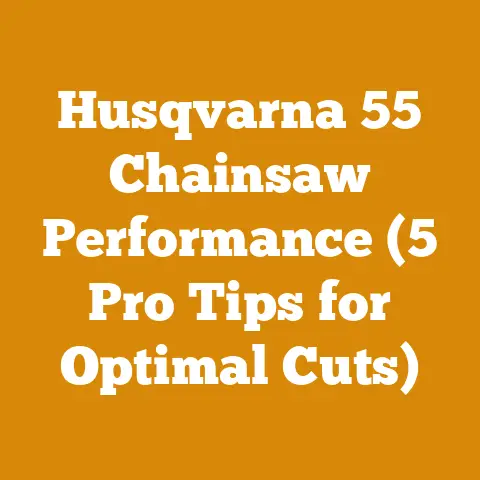Difference in Oregon Chains (5 Expert Tips for Optimal Cutting)
One factor I always consider when evaluating a chainsaw, beyond its power and brand reputation, is the type of chain it uses.
The chain is the workhorse, and its quality significantly impacts cutting speed, smoothness, and overall lifespan.
But navigating their extensive range can be daunting.
Different Oregon chains are designed for specific applications, and understanding these differences is crucial for optimal cutting performance.
Moreover, the type of chain directly affects the resale value of your chainsaw, with well-maintained, high-quality chains adding a premium when you eventually decide to upgrade or sell.
Here, I’ll delve into the world of Oregon chainsaw chains, sharing five expert tips to help you choose the right one for your needs and maximize your cutting efficiency.
I’ll also provide a detailed breakdown of the costs associated with chainsaw chains, helping you budget effectively for your wood processing or firewood preparation projects.
Key Features of Oregon Chains
Before diving into specific chain types, let’s look at the key features that differentiate Oregon chains:
- Pitch: The pitch is the distance between any three consecutive rivets on the chain, divided by two.
Common pitches include 0.325″, 3/8″, and 0.404″.
The pitch must match the sprocket on your chainsaw. - Gauge: The gauge is the thickness of the drive links that fit into the guide bar groove.
Common gauges include 0.043″, 0.050″, 0.058″, and 0.063″.
The gauge must match the guide bar on your chainsaw. - Drive Link Count: The drive link count is the number of drive links in the chain.
This count is specific to the length of your guide bar. Cutter Type: The cutter type refers to the shape of the cutting teeth.
Common cutter types include:- Chisel Cutters: These cutters have square corners and are known for their aggressive cutting speed.
They are best suited for clean wood and experienced users. - Semi-Chisel Cutters: These cutters have rounded corners and are more forgiving than chisel cutters.
They are a good choice for general-purpose cutting. - Micro-Chisel Cutters: These cutters have small, rounded corners and are designed for cutting dirty or abrasive wood.
- Chamfer Chisel Cutters: These cutters are a hybrid design that combines the speed of chisel cutters with the durability of semi-chisel cutters.
- Safety Features: Some Oregon chains incorporate safety features like bumper drive links or depth gauges to reduce the risk of kickback.
- Chisel Cutters: These cutters have square corners and are known for their aggressive cutting speed.
Common Oregon Chain Types
Here are some of the most common Oregon chain types:
- 91 Series (Low-Profile): These chains are designed for small to medium-sized chainsaws and are popular for homeowner use.
They are known for their low kickback and ease of use.
Examples include the 91PX and 91VXL. - 20 Series (Narrow Kerf): These chains are designed for increased cutting efficiency and require less power.
They are often used on battery-powered chainsaws.
An example is the 90PX. - 70 Series (Professional): These chains are designed for professional loggers and arborists.
They are known for their durability and aggressive cutting speed.
Examples include the 72LPX and 73LPX. - 59 Series: The 59 series is another professional-grade option, often found on larger chainsaws used for felling and bucking large trees.
The 59L is a popular example. - VersaCut Series: These chains are designed to be versatile and durable, suitable for a range of cutting conditions.
5 Expert Tips for Optimal Cutting with Oregon Chains
Now that you understand the basics of Oregon chains, let’s dive into five expert tips to help you choose the right one and maximize your cutting performance:
1. Match the Chain to Your Chainsaw and Cutting Needs
This is the most crucial step.
Before purchasing any chain, consult your chainsaw’s owner’s manual to determine the correct pitch, gauge, and drive link count.
Using the wrong chain can damage your chainsaw and lead to poor cutting performance.
Next, consider the type of wood you’ll be cutting.
For clean, softwood, a chisel cutter chain like the 72LPX or 73LPX will provide the fastest cutting speed.
For hardwood or dirty wood, a semi-chisel or micro-chisel chain like the 91VXL or 20BPX will be more durable.
Personal Story: I once made the mistake of using a chisel cutter chain on some old, knotty hardwood.
The chain dulled quickly, and I ended up spending more time sharpening it than cutting.
Lesson learned!
2. Prioritize Safety Features, Especially if You’re a Beginner
Kickback is a dangerous phenomenon that can occur when the tip of the chainsaw bar contacts an object.
It can cause the chainsaw to suddenly jump back towards the user.
If you’re a beginner or working in tight spaces, consider choosing an Oregon chain with safety features like bumper drive links or depth gauges.
These features help reduce the risk of kickback.
The 91 series chains are often a good choice for beginners due to their low-kickback design.
Data Point: According to the Consumer Product Safety Commission (CPSC), chainsaw-related injuries result in tens of thousands of emergency room visits each year in the United States alone.
Proper safety precautions, including using chains with kickback-reducing features, can significantly reduce the risk of injury.
3. Maintain Your Chain Properly for Optimal Performance and Longevity
A sharp chain is a safe chain.
A dull chain requires more force to cut, which can increase the risk of kickback and fatigue.
Regularly sharpen your chain with a chainsaw file or a chain grinder.
Personal Experience: I’ve found that sharpening my chain every time I refuel my chainsaw is a good habit to develop.
This ensures that the chain is always sharp and ready to go.
Tip: When sharpening, maintain the correct filing angles and depth gauge settings as recommended by Oregon.
Use a chain filing guide for consistent results.
In addition to sharpening, regularly clean your chain and guide bar.
Remove any sawdust or debris that can accumulate and reduce cutting efficiency.
Also, lubricate your chain with chainsaw bar and chain oil to reduce friction and wear.
4. Consider the Kerf Width for Efficiency and Power
The kerf width is the width of the cut made by the chainsaw chain.
Narrow kerf chains, like the Oregon 20 series, require less power to cut and can increase cutting efficiency, especially on smaller chainsaws.
However, they may not be as durable as wider kerf chains.
Example: If you’re using a battery-powered chainsaw, a narrow kerf chain can significantly extend the battery life.
5. Don’t Be Afraid to Experiment with Different Chains
The best way to find the right Oregon chain for your needs is to experiment with different types.
Try a few different chains and see which one performs best for your specific cutting applications.
Tip: Keep a log of your cutting experiences with different chains.
Note the cutting speed, smoothness, and durability of each chain.
This will help you make informed decisions in the future.
Cost Considerations for Oregon Chains
Now, let’s delve into the cost considerations for Oregon chainsaw chains.
The price of an Oregon chain can vary depending on the type, size, and features.
Factors Affecting Chain Costs
Several factors influence the cost of chainsaw chains:
- Chain Type: Professional-grade chains like the 70 series tend to be more expensive than homeowner-grade chains like the 91 series.
- Chain Length: Longer chains with more drive links will cost more than shorter chains.
- Features: Chains with safety features or specialized cutter designs may cost more.
- Retailer: Prices can vary between different retailers.
Online retailers may offer lower prices than local hardware stores. - Quantity: Buying chains in bulk can often result in a lower price per chain.
Typical Price Ranges for Oregon Chains
Here’s a general idea of the price ranges you can expect to pay for different types of Oregon chains:
- 91 Series (Low-Profile): \$15 – \$30
- 20 Series (Narrow Kerf): \$20 – \$35
- 70 Series (Professional): \$30 – \$50
- 59 Series: \$35 – \$55
Note: These prices are approximate and can vary depending on the factors mentioned above.
Budgeting for Chainsaw Chains
When budgeting for chainsaw chains, consider the following:
- Chain Replacement Frequency: How often will you need to replace your chain?
This will depend on the type of wood you’re cutting, the frequency of use, and how well you maintain your chain. - Sharpening Costs: Will you sharpen your chain yourself, or will you pay a professional to do it?
Sharpening costs can add up over time. - Maintenance Costs: Factor in the cost of chainsaw bar and chain oil.
- Replacement Costs: Set aside a budget for replacing your chain if it breaks or becomes too worn.
Example: Let’s say you’re a homeowner who uses your chainsaw for occasional firewood cutting.
You might need to replace your chain once a year.
If you choose a 91 series chain that costs \$25 and sharpen it yourself, your annual chain cost would be around \$25, plus the cost of bar and chain oil.
Cost Optimization Tips
Here are some tips to help you optimize your chainsaw chain costs:
- Buy in Bulk: If you use your chainsaw frequently, consider buying chains in bulk to save money.
- Sharpen Your Own Chains: Learning to sharpen your own chains can save you money on professional sharpening services.
- Maintain Your Chain Properly: Proper maintenance can extend the life of your chain and reduce the need for frequent replacements.
- Shop Around: Compare prices from different retailers to find the best deal.
- Consider Refurbished Chains: Some retailers sell refurbished chainsaw chains at a discounted price.
These chains have been inspected and reconditioned and can be a good option for saving money.
The Impact of Chain Choice on Firewood Preparation Costs
The right chain can significantly impact your overall firewood preparation costs.
A sharp, efficient chain will allow you to cut wood faster, reducing the amount of time and labor required.
This can translate into significant savings, especially if you’re preparing a large volume of firewood.
Case Study: A local firewood supplier switched from a standard chain to an Oregon 73LPX chain on their professional-grade chainsaws.
They found that they were able to cut 15% more firewood per day, resulting in a significant increase in productivity and a reduction in labor costs.
Specific Chain Recommendations Based on Wood Type
Here are some specific Oregon chain recommendations based on the type of wood you’ll be cutting:
- Softwood (Pine, Fir, Spruce): 72LPX, 73LPX (for professional use), 91VXL (for homeowner use)
- Hardwood (Oak, Maple, Ash): 72LPX, 73LPX (for professional use), 91VXL (for homeowner use), 20BPX (for smaller chainsaws)
- Dirty or Abrasive Wood: 91PX (low-kickback, durable), 20BPX (narrow kerf, durable)
- Frozen Wood: Chains designed for winter cutting, often with specialized steel alloys.
Consult with your local Oregon dealer.
Understanding Chain Terminology: A Glossary
To further enhance your understanding of Oregon chainsaw chains, here’s a glossary of common terms:
- Anti-Vibration: Features designed to reduce vibration transmitted to the user.
- Bumper Drive Link: A safety feature that helps reduce kickback.
- Chisel Cutter: A cutter with square corners, known for its aggressive cutting speed.
- Drive Link: The part of the chain that fits into the guide bar groove.
- Gauge: The thickness of the drive links.
- Kerf: The width of the cut made by the chainsaw chain.
- Kickback: A dangerous phenomenon that can occur when the tip of the chainsaw bar contacts an object.
- Low-Kickback Chain: A chain designed to reduce the risk of kickback.
- Micro-Chisel Cutter: A cutter with small, rounded corners, designed for cutting dirty or abrasive wood.
- Pitch: The distance between any three consecutive rivets on the chain, divided by two.
- Rivet: A metal fastener that holds the chain together.
- Semi-Chisel Cutter: A cutter with rounded corners, more forgiving than chisel cutters.
- Tie Strap: Connects the drive links to the cutters.
The Importance of Proper Guide Bar Maintenance
While this article focuses on chains, it’s crucial to remember the importance of maintaining your guide bar.
A worn or damaged guide bar can negatively impact chain performance and lifespan.
- Regularly Clean the Guide Bar Groove: Remove any sawdust or debris that can accumulate in the groove.
- Check for Wear and Damage: Look for signs of wear, such as burrs or unevenness.
- Dress the Guide Bar: Use a guide bar dressing tool to remove burrs and restore the shape of the groove.
- Replace the Guide Bar When Necessary: A worn or damaged guide bar should be replaced to ensure optimal chain performance and safety.
Global Considerations for Chain Selection
When selecting an Oregon chain, consider the specific environmental conditions and wood types prevalent in your region.
For example, in tropical regions with dense hardwoods, you may need a more durable chain with a higher tolerance for abrasive materials.
In colder climates, chains designed for winter cutting with specialized steel alloys may be necessary.
Example: In some parts of the world, chainsaws are used to harvest bamboo.
For this application, a chain with a fine-tooth design may be preferable.
The Future of Chainsaw Chain Technology
Chainsaw chain technology is constantly evolving.
Manufacturers are developing new chains with improved cutting speed, durability, and safety features.
Some of the latest innovations include:
- Chains with Diamond-Like Coatings: These coatings increase the hardness and wear resistance of the chain.
- Chains with Optimized Cutter Geometry: These designs improve cutting efficiency and reduce vibration.
- Smart Chains: Chains with sensors that monitor chain condition and provide feedback to the user.
Actionable Takeaways and Next Steps
Choosing the right Oregon chainsaw chain is crucial for optimal cutting performance, safety, and cost-effectiveness.
By following the expert tips outlined in this article, you can make informed decisions and maximize the value of your chainsaw.
Here are some actionable takeaways and next steps:
- Consult Your Chainsaw’s Owner’s Manual: Determine the correct pitch, gauge, and drive link count for your chainsaw.
- Assess Your Cutting Needs: Consider the type of wood you’ll be cutting and the frequency of use.
- Prioritize Safety: Choose a chain with safety features if you’re a beginner or working in tight spaces.
- Maintain Your Chain Properly: Regularly sharpen and clean your chain.
- Experiment with Different Chains: Try a few different chains to see which one performs best for your needs.
- Budget for Chain Costs: Factor in the cost of chains, sharpening, and maintenance.
- Shop Around for the Best Deals: Compare prices from different retailers.
By taking these steps, you can ensure that you’re using the right Oregon chain for your needs and maximizing your cutting efficiency.
Remember, a well-maintained chainsaw with a high-quality chain is an investment that will pay off in the long run.






